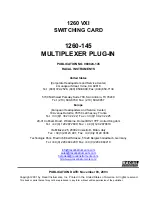
3
Double insulation protection
Fuse
High voltage warning
CAT. III 1000 V
over-voltage protection
CAT. IV 600 V
over-voltage protection
1.1.4 Maintenance practices for safety
The operator must first pull out the test lead when the meter's case is
opened or the battery cover is dismantled.
The designated replacement parts must be used at the moment of
maintenance.
The operator must cut off all relevant power supplies before opening the
meter. At the same time, the operator must avoid damage to the meter's
elements by ensure that he himself doesn't carry any static.
The meter can only be calibrated, repaired and maintained by
professionals.
When the meter's case is opened, the operator must understand the fact
that the presence of some capacitance may promise the dangerous
voltages even if the power supply to the meter is cut off.
The operator should stop using and maintain the meter immediately if any
abnormality has been observed on the meter. The operator must see to it
that the meter cannot be in service unless it is proved conforming.
When the meter is left idle for a long period, the operator shall remove the
battery and place it in a place free from high temperature and humidity.
1.2 Input protection measures
The meter can sustain the maximum input voltage of 1000V (DC) or 750V
(AC) at the moment of voltage measurement.
The meter can sustain the maximum AC voltage of 600V or equivalent
voltage (valid value) when the tests on frequency, electric resistance,
continuity and diode are carried out.
The protective tube (FF630mA/250V) is used for protection purpose when
A and mA current measurements are carried out.





































